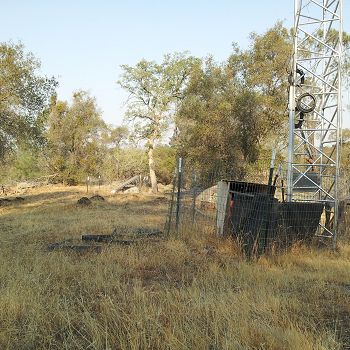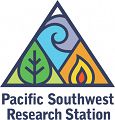San Joaquin Experimental Range (210-520 m elevation)
The San Joaquin Experimental Range (SJER) research site is in the oak woodland foothills of the southern Sierra Nevada.
SJER field area. Photo by Erin Stacy.
Lithology
igneous-felsic intrusive
-
Setting & Research
This site is part of an elevational transect that increases in altitude from west to east.
Sites include San Joaquin Experimental Range, Soaproot Saddle, Providence Creek Headwater Catchments, and Short Hair Creek, spanning a 2300-m elevation range that captures gradients in climate, regolith, soils, and vegetation. Along this transect, bedrock lithology is generally constant (intrusive felsic plutons). Ecosystems range from low-elevation oak savannah (rain-dominated) to high-elevation subalpine forest (snow-dominated). A series of eddy-covariance gas flux towers are installed at these sites (see below). Examples of transect-length work include soil and regolith depth, chemistry, and moisture characterizations; vegetation surveys; forest water-balance research; and wind-blown dust geochemistry and microbiology studies.
Climate, Landscape, Soils, Vegetation
From O'Geen et al., 2018:
The oak savannah San Joaquin Experimental Range is the driest and warmest site out of our field areas. Mean Annual Temperature: 16.6°C. Mean Annual Precipitation: 513 mm yr−1.
Rolling hills at the site serve as small, localized catchments (typically <1 ha) that feed ephemeral streams.
Soils are classified as Ahwahnee (coarse-loamy, mixed, active, thermic Mollic Haploxeralfs), Vista (coarse-loamy, mixed, superactive, thermic Typic Haploxerepts), or Auberry (fine-loamy, mixed, semiactive, thermic Ultic Haploxeralfs) series. The extent of weathering and pedogenesis is low. Soils are coarse textured (loamy sands and sandy loams), shallow to moderately deep (Beaudette and O’Geen, 2016).
Vegetation community comprises scattered blue oak (Quercus douglasii Hook. & Arn.) and interior live oak (Quercus wislizeni A. DC.) with naturalized annual grass understory.
For additional information on climate and vegetation, see also Goulden et al., 2012.
Panorama of San Joaquin Experimental Range. May 2014.
A full size image is available at Sierra Nevada / San Joaquin Hydrologic Observatory digital library (external link).
Active Instrumentation
Flux Tower
An eddy-covariance flux tower was installed at this site in October 2009. Elevation of the tower is 405 m above sea level.
The flux tower is used to analyze the carbon and water balance of the surrounding forest. Instruments on the flux tower track changes in carbon dioxide, water vapor, air temperature, relative humidity, and other atmospheric properties.
Panorama of San Joaquin Experimental Range. May 2014.
A full size image is available at Sierra Nevada / San Joaquin Hydrologic Observatory digital library (external link).
-
Dynamic Map
To fully zoom into a small area, you may need to visit the "Map" button and uncheck "Terrain" view.
-
Data
Flux Tower Transect, SJER - Flux Tower, Meteorology (2009-2018)
10 components • San Joaquin Experimental Range (210-520 m elevation) • Biology / Ecology, Climatology / Meteorology • Mike Goulden; Anne KellyNational - Flux Tower - AmeriFlux Network data (2007-2018)
14 components • Boulder Creek Watershed, Jemez River Basin, Reynolds Creek Experimental Watershed, Susquehanna Shale Hills Critical Zone Observatory, San Joaquin Experimental Range (210-520 m elevation), Soaproot Saddle (1000-1500 m elevation), Short Hair (2670 m elevation) • Climatology / Meteorology • Boulder Creek Critical Zone Observatory; Catalina-Jemez Critical Zone Observatory; Reynolds Creek Critical Zone Observatory; Shale Hills Critical Zone Observatory; Southern Sierra Critical Zone Observatory -
Photos
SSCZO - SJER field area

The SJER tower is situated on a small rise in the north part of the Experimental Range property. The tower is at approximately 405 m in elevation in a landscape of oak and pine woodlands.

With the rains of the past few weeks, the grass around the tower has greened up. Still, 2013-2014 has been a very dry and warm winter.

The SJER tower stands roughly 28 meters tall.

Filters on the air sampling lines at SJER are replaced every month to few months.

A heavy-duty box at the foot of the tower houses the data logger, IRGA, and other electronics.

The vegetation is dominated by oak (Quercus kelloggii) and foothill pine (Pinus sabiniana).

A warm morning at the Range, February 2014.

The SJER office is along the main road, past the turnoff to the tower.

Affordable accommodations are available at the SJER through the U.S. Forest Service.

A meteorlogical station stands near the office and guesthouse buildings.

The landscape was very dry in September 2013.

University of Wyoming researchers visited SJER in September 2013 to conduct geophysical surveys of the subsurface.
This gallery showcases the landscape, vegetation, equipment and facilities at the SJER field area.
SSCZO - Flux Towers

At the San Joaquin Experimental Range (SJER), the SSCZO flux tower sits on a small rise in the oak-pine woodland. This is the lowest site of the flux-tower transect, with the tower installed at 405 m in elevation.

Fully erected, the SJER tower stands about 29 m tall (~95 ft).

However, the tower also telescopes down for maintenance.

Erin Stacy (UC Merced) exchanges the filters on the gas intake.

The flux tower at Soaproot Saddle stands in a small forest clearing. The tower, approximately 39 m tall (125-130 ft), is surrounded by a mix of Ponderosa pine and oak. Here the WyCEHG (Wyoming) sets out equipment to conduct geophysical surveys in the tower footprint.

Defensive measures were taken for the Soaproot Saddle tower in advance of a prescribed burn. The Clarence Burn burned up to a nearby firebreak in January 2014, but did not burn the area immediately around the tower

Matt Meadows (Field Manager, UC Merced) begins the climb for routine tower maintenance in a late January storm, 2014.

Pete Hartsough (collaborator, UC Davis) stands next to the Soaproot tower, September 2013, with core tubes in hand. A large drilling unit cored soil and saprolite to a depth of ~4 m on most attempts at this site.

The P301 tower is the tallest of the four towers at 50 m (160 ft), plus a lightning rod. It stands near the top of the Providence catchments at 2015 m in elevation.

The P301 tower near the end of the 2014 winter.

Matt Meadows (Field Manager, UC Merced) shows off the filter intakes at the top of the P301 tower.
An eddy covariance flux tower is located near the top of the P301 watershed. Instruments collect data on temperature, relative humidity, and fluxes of carbon dioxide and water vapor to determine the physiological responses of the site (for example, how photosynthesis increases with light) and summed over a year to determine the carbon balance of a site (how much carbon it is gaining or losing). Three other flux towers have been instrumented at different elevations with the Sierras including the San Joaquin River, Soaproot, and Short Hair Creek.
This west-east transect spans elevation gradient from 400 m to 2700 m. The change in elevation is accompanied by a slight increase in precipitation, but the main change is a shift from rain-dominated precipitation to snow-dominated precipitation. The climatic shift plays out in other ways as well. At lower elevations, high temperatures and low water availability limit evapotranspiration by vegetation. Meanwhile, forest activity (evapotranspiration) at higher elevations is limited by cold winter temperatures. There is a sweet spot at middle elevations of yera-round evapotranspiration and forest activity.
Photo galleries of each flux tower are available: San Joaquin Experimental Range; Soaproot Saddle; Providence subcatchment P301; and Short Hair Creek.
-
Partner Organizations
-
Geology
- igneous-felsic intrusive
SJER – 400 m elevation
Quad: Millerton LakeWard Mountain Trondhjemite (Kw) (formerly Leucotonalite of Ward Mountain)
“Medium- to fine-grained biotite leucotonalite (trondhjemite). Rock appears gneissic in outcrop and deformed and recrystallized in thin section... Biotite, generally in tiny plates, is the sole primary mafic mineral. Secondary muscovite in plates as much as 2 mm across is abundant locally... U-Pb age of … 115 m.y” (Bateman and Busacca 1982). “Biotite averages about 10 percent of the rock… most samples contain less than 5 percent alkali feldspar… Deformed trondhjemite, which constitutes the bulk of the rock, is fine grained and gneissic, and when viewed in thin section it can be seen to have a granoblastic texture… The Ward Mountain Trondhjemite intrudes the Bass Lake Tonalite” (Bateman 1992).Soaproot Saddle, 1100 m elevation
Quad: Shaver Lake
Bass Lake Tonalite (Kbl, formerly Tonalite of Blue Canyon)P301, 2000 m elevation
Quad: Huntington Lake
Dinkey Creek Granodiorite (Kdc, formerly Granodiorite of Dinkey Creek)Short Hair Creek, 2700 m elevation
Quad: Blackcap Mountain
Aplite and felsic quartz monzonite dikes (Kap)
Granodiorite of Dinkey Creek (Kdc, see description for P301)
Explore Further



